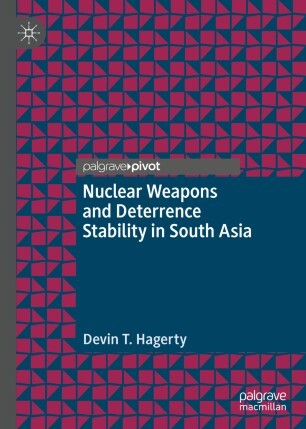The debate on the strategic dimension of South Asian politics and its varying patterns under the influences of India-Pakistan protracted conflict has always attracted intellectual circles of the international community. The proponents of arms control and disarmament and the advocators of international non-proliferation regime generally focus on the South Asian nuclear politics in their analysis. In this way, an academic evaluation of the South Asian conflict between the pair of nuclear weapon states presents varying analytical arguments of leading intellectual communities. Analogous to numerous other studies discussing the various aspects of the South Asian security environment under the nuclear shadows, the book under review tried to provide a fresh image of the India-Pakistan strategic competition. Devin T. Hagerty, in Nuclear Weapons and Deterrence Stability in South Asia, has attempted to examine the theoretical conception of deterrence and its application in the strategic competition of two South Asian neighbours. As a professor of political science at the University of Maryland, Baltimore Country (UMBC), Hagerty became the founding director of the UMBC’s Global Studies program. His professional capabilities in the fields of international relations, national security policy, and nuclear weapons and deterrence assist him in describing different features of South Asian strategic politics. The expertise in the strategic dynamics of the great power politics and their impacts on the South Asian nuclear rivals have produced several other studies by Devin T. Hagerty.
The book under review is divided into five brief chapters, where the first chapter briefly introduces the central theme of Hagerty’s analysis. After formally describing the main argument of the study, the subsequent chapters attempt to cover the different topics respectively. The discussion starts with the recent episode of the South Asian conflict between the nuclear rivals by calling it a microcosm of the superpower balance (p. 02). In the initial introductory pages, the author highlights his three-dimensional points of arguments, which mainly focus on the post-nuclear five-crisis scenarios between New Delhi and Islamabad, the nature of stability in Indo-Pakistani mutual nuclear deterrence, and the measures taken by both nuclear competitors for enhancement of stability in the regional nuclear balance (p. 06). Hagerty’s study’s second and third chapters attempt to cover the New Delhi-Islamabad crisis in the overt nuclearised phase. The second chapter explained the nature of the South Asian crisis in the post nuclearised environment, whereas the third chapter analysed the same feature of nuclearised subcontinent in the presence of external players. The US crisis management approach for its South Asian nuclear allies and the nature of American diplomatic forces in deescalating the crisis situation between New Delhi and Islamabad cannot be ignored, according to the author. In addition to the American role of crisis management, the status of nuclear deterrence and the lack of favourable conventional military options are considered responsible factors in normalising the crisis situation between South Asian strategic competitors.

The last part of the book ends the debate in the fourth and fifth chapters by examining the nature and status of deterrence stability and its relevance to South Asian strategic politics. A comprehensive theoretical survey of the deterrence stability consisting of contrasting positions of “proliferation pessimists” and “deterrence optimists” commence the intellectually logical explanation of Hagerty’s arguments (p. 69). The examination of the recent crisis of 2019 is called an inseparable element of ugliness in the South Asia nuclear conflict, which established the state of ugly stability between New Delhi and Islamabad (p. 79). The continuation of the conversation on the status and scope of deterrence stability in South Asia led the author to display his determination in addressing the issue of ugliness in the regional fragile strategic balance between India and Pakistan. The articulation of some practical measures for lessening the status of ugliness and promoting stability in the New Delhi-Islamabad nuclear arms competition concluded the whole debate in the book. It is an idyllic reflection of the author’s unrealistic approach of framing the India-Pakistan nuclear conflict in a utopian way. In response to the prevailing unstable scenarios on the prolonged strategic contest in the nuclearised subcontinent, Hagerty’s study recommended six steps for the betterment of regional stability between India and Pakistan.
Apart from the book under review, other studies of the Hagerty investigate an intense South Asian security situation under the nuclear shadows. The other prominent analysis of the Hagerty outlined in The Consequences of the Nuclear Proliferation: Lessons from South Asia (1998). Along with some co-authored and edited volumes on the evolving nuclear politics in world politics generally and its South Asian direction specifically, the author is persistently contributing to the existing literature on the strategic arrangements of the international system. The analysis on the South Asian version of international strategic politics highlights slightly the role of the US in mediating the India-Pakistan tensions in the presence of their persistently swelling nuclear weapon capabilities. The book Nuclear Weapons and Deterrence Stability in South Asia is an appropriate for students interested in the strategic dimensions of world politics and their impacts on the South Asian strategic competition. It is an opposite account of various analysis addressing the question of nuclear deterrence and its South Asian practices while examining the status of strategic stability between India and Pakistan.





